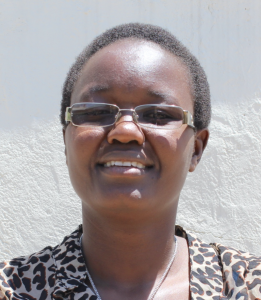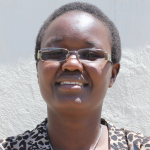In Sundolo B Community, it's the children who suffer the most health issues from the contaminated water. Chronic cough, diarrhea, skin rashes, and typhoid are all causing emotional and financial strain on the community's 175 people.

"Getting clean water is a challenge because the water is always dirty," said Beatrice Mukangai, 50. "As a mother, [I] am always so stressed thinking about the well-being of my family until I forget other important things."
The spring provides plenty of water, which the community members see as a blessing compared to those they know who don't have any source of water. However, the health consequences of drinking water from Christopher Lumbasi Spring make this a mixed blessing at best.
"I know that water is a blessing," explained Erick L., who is ten years old (pictured below at the spring). "But, to me, the situation is different. My siblings and I are always sick, and when we visit the hospital, we are told the cause is taking contaminated water."

And if the health consequences weren't enough, the spring also suffers from overcrowding, which adds a lot of waiting time into community members' schedules, and a slippery, steep access point.
The people of Sundolo B added an improvised discharge pipe in an attempt to speed up the water collection process, but still find themselves all sharing (and drinking from) the same water-scooping container instead.

The spring is open, which makes it available to any and all sources of contamination: livestock, wildlife, farming fertilizer, and, of course, people.
"I pray that the spring will be protected and all these problems will be put to an end," Erick concluded.
What We Can Do:
Spring Protection
Protecting the spring will help provide access to cleaner and safer water and reduce the time people have to spend to fetch it. Construction will keep surface runoff and other contaminants out of the water. With the community’s high involvement in the process, there should be a good sense of responsibility and ownership for the new clean water source.
Fetching water is a task predominantly carried out by women and young girls. Protecting the spring and offering training and support will, therefore, help empower the female members of the community by freeing up more of their time and energy to engage and invest in income-generating activities and their education.
Training on Health, Hygiene, COVID-19, and More
To hold trainings during the pandemic, we work closely with both community leaders and the local government to approve small groups to attend training. We ask community leaders to invite a select yet representative group of people to attend training who will then act as ambassadors to the rest of the community to share what they learn. We also communicate our expectations of physical distancing and wearing masks for all who choose to attend.
The training will focus on improved hygiene, health, and sanitation habits in this community. We will also have a dedicated session on COVID-19 symptoms, transmission routes, and prevention best practices.
With the community’s input, we will identify key leverage points where they can alter their practices at the personal, household, and community levels to affect change. This training will help to ensure participants have the knowledge they need about healthy practices and their importance to make the most of their water point as soon as water is flowing.
Our team of facilitators will use a variety of methods to train community members. Some of these methods include participatory hygiene and sanitation transformation, asset-based community development, group discussions, handouts, and demonstrations at the spring.
One of the most important issues we plan to cover is the handling, storage, and treatment of water. Having a clean water source will be extremely helpful, but it is useless if water gets contaminated by the time it is consumed. We and the community strongly believe that all of these components will work together to improve living standards here, which will help to unlock the potential for these community members to live better, healthier lives.
We will then conduct a small series of follow-up trainings before transitioning to our regularly scheduled support visits throughout the year.
Training will result in the formation of a water user committee, elected by their peers, that will oversee the operations and maintenance of the spring. The committee will enforce proper behavior around the spring and delegate tasks that will help preserve the site, such as building a fence and digging proper drainage channels. The fence will keep out destructive animals and unwanted waste, and the drainage will keep the area’s mosquito population at a minimum.

 Protected Spring
Protected Spring
 Rehabilitation Project
Rehabilitation Project






































